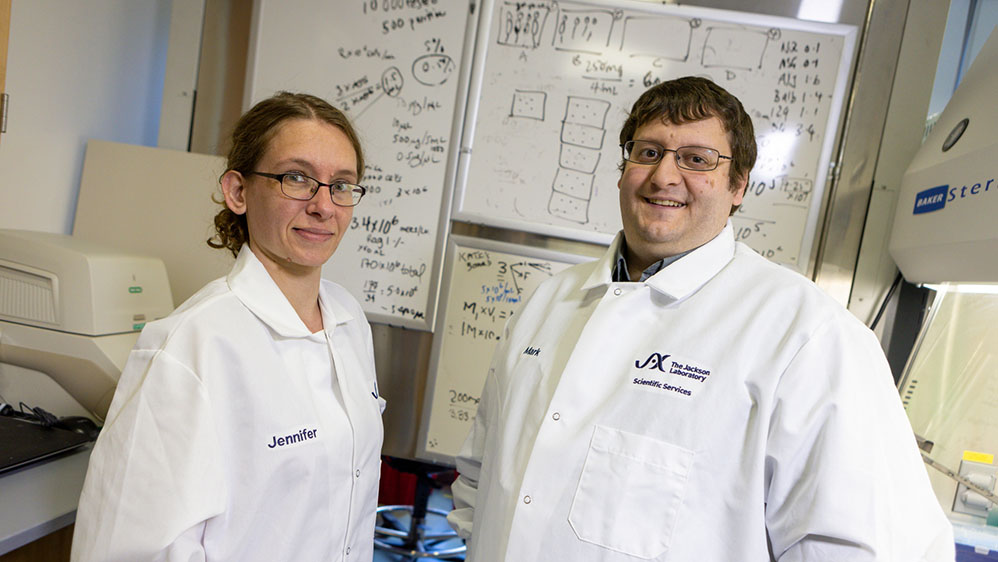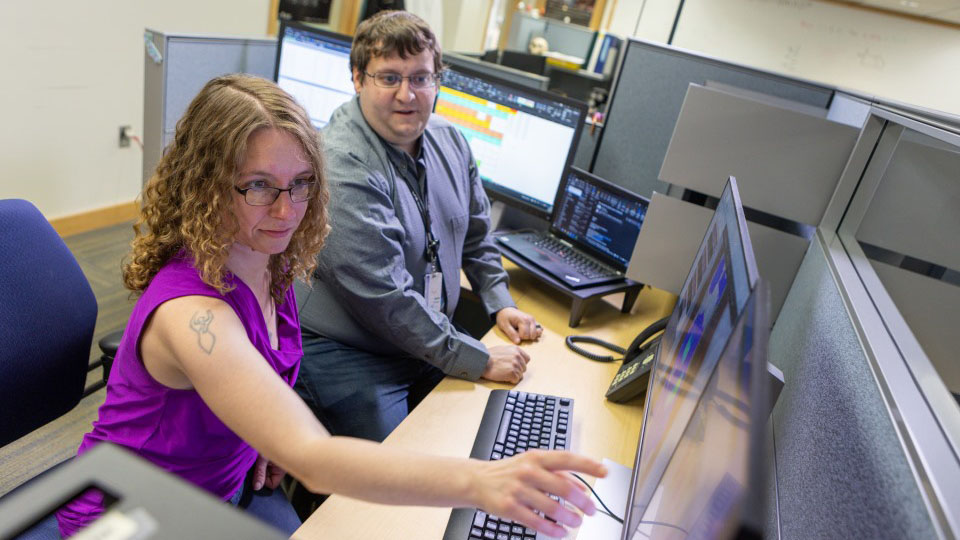 (l to r) The Jackson Laboratory's Jennifer Sargent and Mark Warner
(l to r) The Jackson Laboratory's Jennifer Sargent and Mark Warner
Researchers from the Xenograft and Live Imaging Services at The Jackson Laboratory have won a prestigious publication award, highlighting their work exploring the effects of diverse genetic backgrounds on cancer using xenograft mouse models.
Jennifer Sargent, supervisor, and Mark Warner, xenograft studies technologist, have won the Disease Models and Mechanisms (DMM) Outstanding Paper Prize 2022 for their Resource Article, “Genetically diverse mouse platform to xenograft cancer cells.” This paper was conducted under the leadership of Muneer Hasham, Ph.D., associate director, and the paper’s senior author, with their research funded by National Cancer Institute under the Innovative Molecular Analysis Technologies program.
Lead authors Sargent and Warner share similar backgrounds and have meaningful connections to the work they do every day in their current positions. Each graduated from MDI High School — just a year apart from one another in 2002 and 2003 — and both currently live in Lamoine, Maine. They each started at JAX as animal caretakers working in the mouse rooms, and in a relatively short span of time have advanced to winning top recognition from an international research publication.
A personal passion for cancer research
Sargent started at JAX 10 years ago, working up to a mid-level technologist in the mouse rooms before transferring to Xenograft and Live Imaging Services as a xenograft research technician. For the past year she has been the supervisor of Xenograft and Live Imaging Services.
She was initially inspired to work in the department because of a family connection.
“When working in [mouse room] AX27, I sent mice to the doctor of a family member who was undergoing cancer treatment,” she said. “I had wanted to go into research for some time and looked up other positions the lab had — the job for xenograft technician popped up. I found out that I would be doing similar work to what was being done with my family member’s doctor, applied and got the position.”
Warner’s path to Xenograft and Live Imaging Services was also influenced by a family connection to JAX research.
“I wanted to work in research and particularly on cancer research, especially given a family history, including my sister, who is a leukemia survivor,” he said.
He started at JAX as an animal care trainee in May 2017. Once the initial training period was complete, he was selected to work in a Research Animal Facility (RAF), caring for researchers’ mice, eventually becoming a full animal care technician for the RAF and running two mouse rooms. In September 2020, he got his first position in Xenograft and Live Imaging Services as a research assistant, and in May 2022, he became a xenograft studies technician.
Their work is complicated, so both Sargent and Warner have had plenty of practice explaining what they do to people who aren’t familiar with their research.

The power of PDX
“PDX R & D Core is short for Patient Derived Xenograft Research and Development Core,” explained Warner. “We are a part of the Scientific Services program at JAX that focuses on cancer research. We work with several other groups and do experiments with other Scientific Services and labs —both internal and external clients — and other JAX locations, as well as obtain internal and external funding to work on our own experiments.”
Sargent followed up with additional details on the science: “We implant patient tumors and cancer cell lines into mice to look at growth of different cancers. From there we do efficacy studies to see what options patients may have to help treat their cancer.”
The research outlined in the winning DMM paper addresses a long-time limitation in biomedical research: cancer mechanisms differ between animal species. To overcome this problem, researchers developed patient-derived and human cell line xenografts (PDX and CDX, respectively), in which human cancer cells or tumor fragments are engrafted in graft-receptive animals, such as mice. But PDX mice were limited to two strains, restricting research into the effects of different background genetics on tumor growth and therapy response.
To address the issue, the team led by Hasham developed and characterized genetically diverse mouse strains to use in CDX research. In the resulting DMM paper, the team presents a panel of five Rag1 mutant (immunodeficient) mouse strains that can be successfully engrafted with human cancer cells. Their findings show that the growth characteristics of the cells are much more dependent upon the mouse strain than tumor type, underscoring the importance of background genetics in cancer research.
Writing a scientific paper takes time, patience and, sometimes, very late nights, they said.
Working toward a common goal of bettering humankind
“I worked many days with Dr. Hasham and Jen and spent several late nights messaging with Jen to write, read, edit, re-read, re-write and finalize this paper to get the wording just right for publication in DMM. We met many times with Dr. Hasham to ensure every point was coming across well and as intended,” said Warner.
Both credit their varied roles at JAX for helping them make scientific connections that others might miss. They also believe the opportunities to advance at JAX make the Laboratory an ideal employer, while the mission of the organization makes work done by every employee meaningful.
“That we are working on all kinds of cures for various diseases and making a global, long-term impact. This is the reason I started at JAX. I wanted to do the research, and if I couldn’t do the research at first, at least I could care for the mice that would be used for research all over the world and just be a part of that,” said Warner.
He appreciates the perspective this award can give to all JAX employees on the importance of their contributions to the Laboratory itself, and to the broader scientific research community.
“I just want everyone to know that everything you do here at JAX is working toward a common goal of bettering humankind. Everything we do has an impact on many types of research around the world, from operations to animal care to research,” he said. “Also, if you put in the work and are willing and eager to learn, you can work to do research and have a more direct impact if that is what you want — even if you do not have a degree, like myself.”